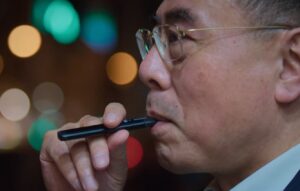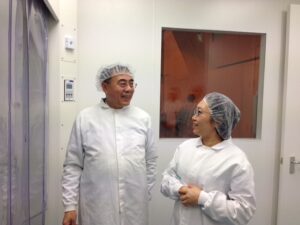//Interview with Hon Lik: original inventor of the e-cigarette
Posted 25/08/2020 11:49am
Mr Hon Lik is based in China and retained as a consultant by Imperial Brands’ vape subsidiary, Fontem Ventures. As he speaks to James Campbell, Senior Communications Manager, the views reflected in this article are his own and may not necessarily reflect those of either Fontem or Imperial.
James Campbell: When you see a person vaping in the street, do you feel pride or happiness that you invented the device?
Hon Lik: Yes, there is pride. Vapes are a highly humanised product that relieve many of the withdrawal symptoms of conventional cigarettes, letting users enjoy nicotine alongside potential lower risks than cigarettes. They are, of course, only for adult smokers. Overall, I’m satisfied and gratified to witness this revolution that’s changing the lifestyle of millions of adult smokers around the world.

Mr Hon Lik using a myblu device. Image: Fontem Ventures
JC: As the ‘inventor of the e-cigarette’ it must be fascinating to watch the evolution of your device into so many types and variants. Are there certain devices – i.e. pods or sub-ohm tank systems – that you prefer to others?
HL: If you make the device ‘avant-garde’ it becomes more niche and for enthusiasts only. For the mainstream who want to reduce their cigarette consumption, or quit smoking entirely, I believe the price-quality combination and flavours are more important factors than being able to customise or alter the voltage. It’s great, however, that consumers have choices and leading vape manufacturers need to help facilitate that. I think it’s the responsibility of the likes of Imperial Brands to ensure their products are of the highest quality and perform exactly as designed. That’s crucial to boosting consumer confidence.
JC: Countries like the UK have really adopted vaping, while others – like Australia – don’t seem as keen. Why do you think this is the case?
HL: Maybe Australia is being overcautious as this is still considered a new product category. I believe if they consider the evidence from the UK, they’ll find that enabling a well-regulated vaping category will help their adult smokers to make better choices.
JC: The Netherlands may legislate to restrict e-liquid flavours. What do you think about this, and how important are different flavours to the vaping experience in terms of helping adult smokers transition?
HL: When we first commercialised the e-cigarette we only had two variants – tobacco and latterly tobacco-mint. Now there are hundreds of flavours! I didn’t think of developing fruit flavours, but it has certainly been effective. Vapes are designed for and marketed to adults who are adjusting to giving up cigarettes. This is often a struggle. In this world there are many cultural differences, and consumers with all kinds of different needs. Vape flavours help cater to this. I personally think regulators should focus on enforcing age limits rather than banning flavours – we should all be as strict as possible on any potential adoption by vulnerable populations like youth.
JC: Are you pleased with the progress made by tobacco harm reductionists and next generation nicotine products globally, or frustrated they’re not being adopted more widely and quickly?

Hon Lik takes a keen interest in electronic vapour product research. Image: Fontem Ventures
HL: Focusing on vaping, media coverage continues to be very confusing to many consumers. The principle of tobacco harm reduction has always been based on the relative harm of vaping compared to smoking. I believe an objective analysis of both the scientific and real-world evidence suggests adult smokers would benefit from transitioning to next generation products (NGPs) like vapes. However, anti-vaping activists always focus on the potential for absolute harm of vaping – i.e. vaping without having ever smoked cigarettes, which is not the point of the product – rather than comparing vape aerosol to considerably more harmful cigarette smoke. They also use extreme language, including describing nicotine as ‘poison’, which I think is incredibly misleading.
JC: Why do you think vaping is more popular in some countries than others, and why does it seem to be particularly struggling to gain traction in many BRIC (Brazil, Russia, India, China and South Africa) nations?
HL: Cost is one of the hurdles on the world map and it will require further innovation to make future NGPs more affordable and accessible to everyone. This will inevitably occur, in my opinion, and hopefully allow adult smokers everywhere to benefit from potential tobacco harm reduction.
JC: Do you have any thoughts of the state of the science in terms of vape/NGP research?
HL: The growth of NGPs has kickstarted an entire new industry, not just a category. Now we have many brands, but if we look to the future there remains incredible room for improvement in terms of technology. New battery technologies could have a huge impact, as could the development of nicotine liquids with significantly improved risk profiles. My dream is that we can produce NGPs with no tangible negative impact on user health. In the future, vaping could hopefully even develop into a category intended for regular consumption like a cup of coffee… if the innovation is there.
JC: With the advent of newer NGPs, like heated tobacco and tobacco-free oral nicotine pouches, do you still think vaping is the most effective form of potential tobacco harm reduction?
HL: Yes. I believe vaping is currently the most effective way of facilitating potential tobacco harm reduction and has a promising track record in terms of helping millions of adult smokers move away from conventional cigarettes. Certainly, NGPs like tobacco-free oral pouches could complement this; for instance, in terms of helping adult smokers in situations where they cannot vape, such as on a plane.
JC: Finally, where does the inventor of e-cigarettes see NGPs in 20 years’ time… conventional cigarettes banned and tobacco harm reduction embraced? Nicotine potentially seen in a new light, more like caffeine?
I am optimistic the continued development of vapes will be further enhanced by sensible and pragmatic regulation. In many countries, regulation doesn’t yet reflect the scientific evidence base supporting vaping, or the fact that so many former adult smokers are using them. In the future, thanks to the development of new technologies and the application of new materials, I suspect we’ll experience a new market growth period.

Vapes have evolved considerably since his original patent. Image: Fontem Ventures
JC: Are there any amazing new NGP technological innovations you foresee?
HL: I truly believe the innovation has only just started. In the 1960s, owing to scientific and technological limitations, nicotine was considered the main harmful material in tobacco. Today, everyone knows it’s the harmful chemicals present in cigarette smoke produced via the process of tobacco combustion. The media isn’t correcting this crucial mistake, while also focusing on the absolute harm of vaping rather than its relative harm compared to continued cigarette smoking.
The media are also often guilty of sensationalist headlines without describing the quality of the science data, or investigating more deeply. In the coming decades, after long-term data collection, I think it will be revealed that NGPs like vapes are clearly harm reduced compared to combustible tobacco – hopefully creating a pathway for tens of millions more smokers to leave conventional cigarettes behind.
—
You are free to share this content with credit to Imperial Brands under a Attribution-NoDerivatives 4.0 International (CC BY-ND 4.0) license.

